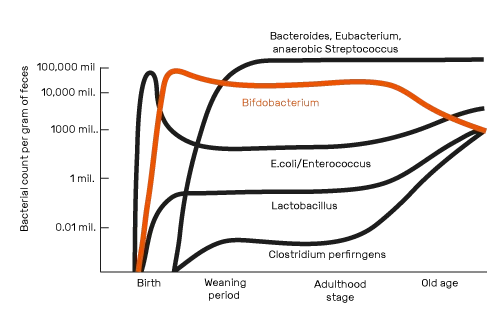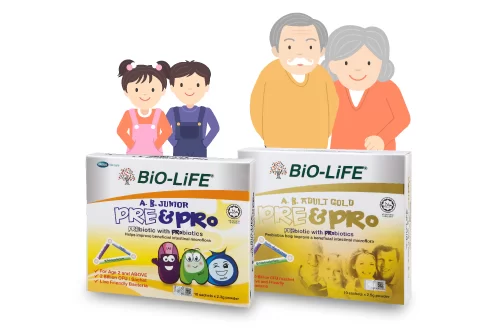
Evolution of Microflora with Aging
Feb 11, 2020
Introduction
The human body is colonized by trillions of microorganisms or bacteria, which altogether are called the human microflora. Although we could not see them through our bare eyes, we acquire these bacteria during birth and the first year of life and they live with us throughout our lives. These bacteria live on the skin, in the nose, throat, mouth, vagina, and especially in the gut, where majority of them are found.
A balanced ratio of bacteria present in the gastrointestinal tract plays a crucial role in maintaining our health. When there is an imbalance of good bacteria and bad bacteria in our gut, this affects the digestive and immune function of the body. It is important to ensure a balanced ratio of 85% of good bacteria to 15% of bad bacteria in our gut and keep the imbalance of microflora at bay!

Aging is a natural process. Everyone must undergo this phase of life at his or her own time and pace. Aging not only affecting an individual’s body and cells but at the same time, also affecting the microorganisms that exist in the gut. Bifidobacteria are y-shaped bacteria that are found in our intestine, which is incredibly important for our health. Despite its immense importance to the body, Bifidobacteria typically make up less than 10% of the bacteria in the adult gut microflora. Bifidobacteria populations are the most abundant genus present in a healthy infant gut. During adulthood, the level decreases slowly but remain relatively stable. The drastic drop in the number of bifidobacterial happens during old age.

Beneficial bacteria – Bifidobacteria

Figure 1: Bifidobacteria decreases with age
Gut microflora is established during birth and evolves with age. From birth, the microflora diversity increases and converges toward an adult-like microflora by the end of the first 3–5 years of life. During birth, the first bacteria that we acquire depend on the birth delivery process, either born natural or through the c-section method. The baby feeding method (breast milk or drinking formula powder) will influence the microflora in our first year of life. Diet will influence the composition of microflora in all stages of our life. As we get older, microflora alterations depend on our diet, living environment, and lifestyle. Consumption of antibiotics will also alter the composition of our microflora.
Thus, there are two main life stages in which we could improvise our body microflora. Firstly is during the childhood stage, where we could top up the number of good bacteria in the body before the composition become stable; secondly is when we get older, we need to replace the number of good bacteria in the body. Consumption of probiotics would be a good choice to increase the number of good bacteria in the gut. Functioning like a “Superhero”, probiotics safeguard the condition in the digestive tract just like how you’d want the road to be as you drive each day. Good bacteria are like a law-abiding driver on the road, they ease the digestive tract for a smoother flow as it protects the gut.

If you hope to improvise your gut microflora, BiO-LiFE AB Junior Pre & Pro and BiO-LiFE AB Adult Gold Pre & Pro would be a good choice. Both are synbiotic products which targeted for children aged 2 years old and above, and senior citizen aged 50 years old and above. Both the products provide a combination of probiotic and prebiotic that restores the balance of microflora in the gut to improve digestion, nutrient absorption and immunity.
Thus, stay healthy by maintaining the number of good bacteria in your body!
Find out more on our probiotics supplements at http://Biolife.2.vu/probiotics
References
- Mitsuoka, T. (1978). Intestinal bacteria and health: an introductory narrative. Harcourt Brace Jovanovich Japan.
- Rodríguez, J. M., Murphy, K., Stanton, C., Ross, R. P., Kober, O. I., Juge, N., … & Marchesi, J. R. (2015). The composition of the gut microbiota throughout life, with an emphasis on early life. Microbial ecology in health and disease, 26(1), 26050.
- Arboleya, S., Watkins, C., Stanton, C., & Ross, R. P. (2016). Gut bifidobacteria populations in human health and aging. Frontiers in microbiology, 7, 1204.
- Nagpal, R., Mainali, R., Ahmadi, S., Wang, S., Singh, R., Kavanagh, K., … & Yadav, H. (2018). Gut microbiome and aging: Physiological and mechanistic insights. Nutrition and healthy aging, 4(4), 267-285.
- da Silva, G. J., & Domingues, S. WE ARE NEVER ALONE: LIVING WITH THE HUMAN MICROBIOTA.



